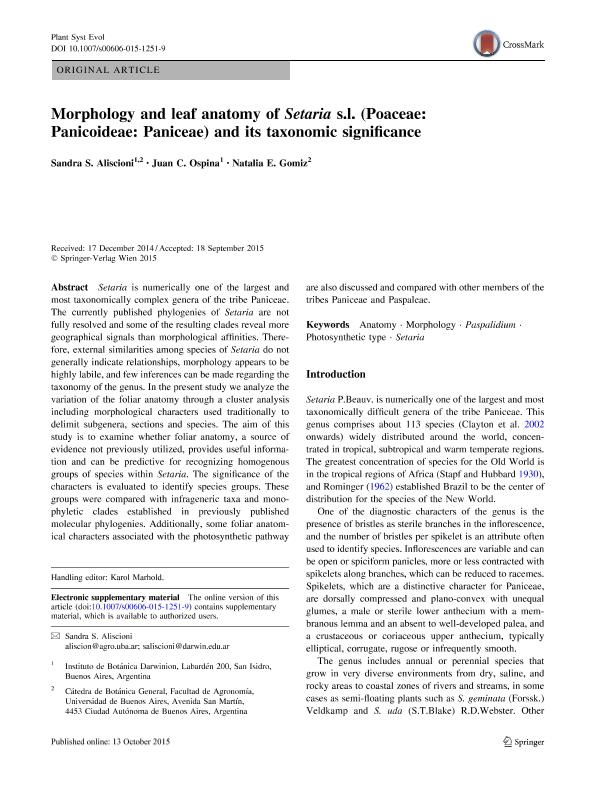Artículo
Morphology and leaf anatomy of Setaria s.l. (Poaceae: Panicoideae: Paniceae) and its taxonomic significance
Fecha de publicación:
02/2016
Editorial:
Springer Wien
Revista:
Plant Systematics and Evolution
ISSN:
0378-2697
e-ISSN:
2199-6881
Idioma:
Inglés
Tipo de recurso:
Artículo publicado
Clasificación temática:
Resumen
Setaria is numerically one of the largest and most taxonomically complex genera of the tribe Paniceae. The currently published phylogenies of Setaria are not fully resolved and some of the resulting clades reveal more geographical signals than morphological affinities. Therefore, external similarities among species of Setaria do not generally indicate relationships, morphology appears to be highly labile, and few inferences can be made regarding the taxonomy of the genus. In the present study we analyze the variation of the foliar anatomy through a cluster analysis including morphological characters used traditionally to delimit subgenera, sections and species. The aim of this study is to examine whether foliar anatomy, a source of evidence not previously utilized, provides useful information and can be predictive for recognizing homogenous groups of species within Setaria. The significance of the characters is evaluated to identify species groups. These groups were compared with infrageneric taxa and monophyletic clades established in previously published molecular phylogenies. Additionally, some foliar anatomical characters associated with the photosynthetic pathway are also discussed and compared with other members of the tribes Paniceae and Paspaleae.
Palabras clave:
Anatomy
,
Morphology
,
Paspalidium
,
Photosynthetic Type
,
Setaria
Archivos asociados
Licencia
Identificadores
Colecciones
Articulos(IBODA)
Articulos de INST.DE BOTANICA DARWINION (I)
Articulos de INST.DE BOTANICA DARWINION (I)
Citación
Aliscioni, Sandra Silvina; Ospina Gonzalez, Juan Camilo; Gomiz, Natalia Elva; Morphology and leaf anatomy of Setaria s.l. (Poaceae: Panicoideae: Paniceae) and its taxonomic significance; Springer Wien; Plant Systematics and Evolution; 302; 2; 2-2016; 173-185
Compartir
Altmétricas




